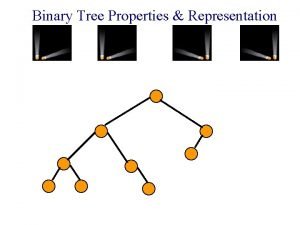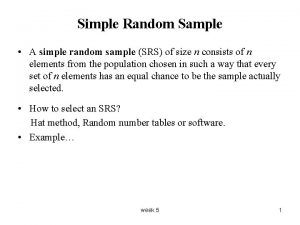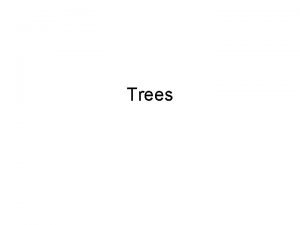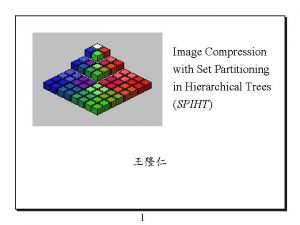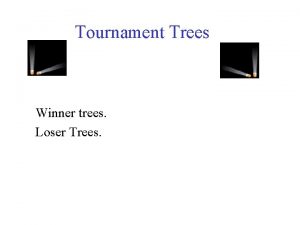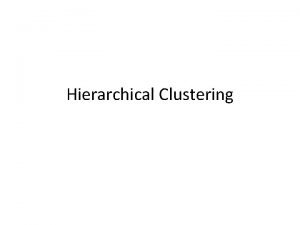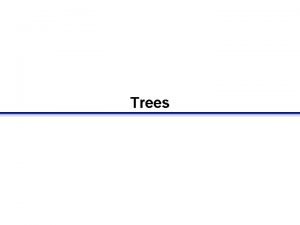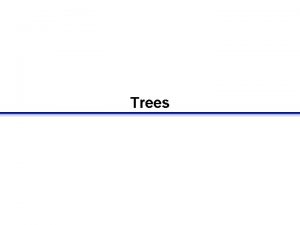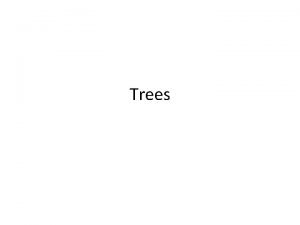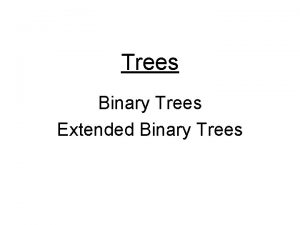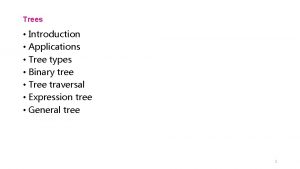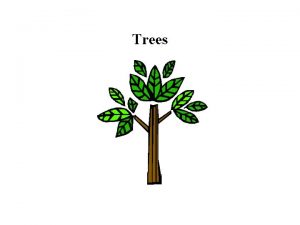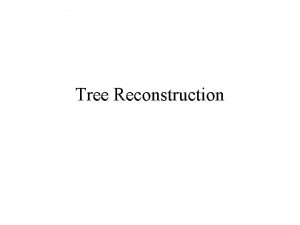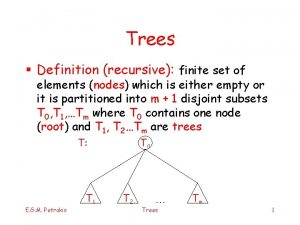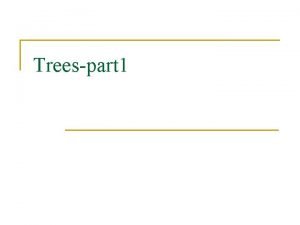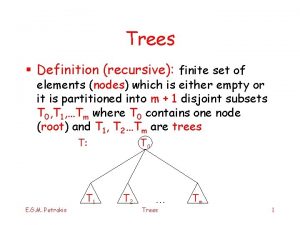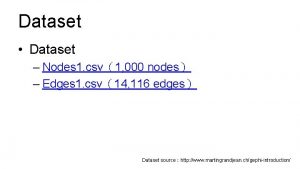Trees Tree Consists of a set of nodes
























- Slides: 24

Trees

Tree • Consists of a set of nodes and directed edges connecting them • Rooted trees – One node is distinguished as root – Every node c, except root, has exactly one incoming edge from another node p. p is c’s parent. – There exists a unique path from root to any node

Tree Properties and Definitions • A tree with N nodes has N-1 edges • Siblings – Nodes with same parent • Ancestor & descendant – If there is a path from u to v, v is the descendant of u & u is the ancestor of v – If u ≠ v, v is proper descendant of u & u is proper ancestor of v

Definitions (Contd. ) • Depth of a node – Length of path from root to node – Depth of root is 0 – Depth of any node is one more than its parent’s depth • Height of a node – Length of path from node to deepest descendant leaf • Size of a node – Number of descendants of the node (including itself) • Height of a tree – Height of the root of the tree

Example

Recursive Definition • A tree is – Either empty – Or it consists of root and zero or more of subtrees • Roots of subtrees connected by an edge to root of tree

Illustration

Implementing Trees • Straightforward method – Every node in the tree has link to each of its children – Number of children can vary greatly – Child count may not be known before hand – Leads to space wastage • First Child – Next Sibling method – Children are stored as linked lists – Node stores link to leftmost child and right sibling

Illustration

Binary Tree • A tree in which each node has at most two children – Left child and right child • Recursive definition – A binary tree is either empty, or it consists of a root, a left tree and a right tree • Applications – Expression trees in compilers – Huffman coding tree – Binary search trees

Applications

Binary Tree Implementation • Binary node – Stores an individual node in a binary tree – Consists of data (object to store), references to right child node and left child node (both binary nodes) • Binary tree – Stores the root node of the tree

Binary. Node and Binary. Tree public class Binary. Node{ private Object element; private Binary. Node left; private Binary. Node right; } public class Binary. Tree{ private Binary. Node root; }

Methods in Binary. Node • Two constructors – First one takes in element, right node, and left node – Second one does not take in any parameters (all are set to null) • • Setters for element, left, and right Getters for element, left, and right Computing size and height of nodes Tree traversal methods (Preorder, Inorder & Postorder)

Computing Size • Recursive method that terminates at leaf nodes public int size(){ if(left == null && right == null) return(1); if(left == null) return(right. size() + 1); if(right == null) return(left. size() + 1); return(left. size() + right. size() + 1); }

Computing Height • Recursive method terminating in leaves public int height(){ if(left == null && right == null) return(0); if(left == null) return(right. height() + 1); if(right == null) return(left. height() + 1); if(right. height() => left. height()) return(right. height() + 1); return(left. height() + 1);

Tree Traversals • Accessing (or processing) individual nodes of a tree • Usually implemented recursively • Three kinds of tree traversal – Preorder – Inorder – Postorder • Our example considers printing node information

Preorder Traveral • Process current node • Process left subtree • Process right subtree public void print. Pre. Order(){ System. out. println(element. to. String()); if (left != null) left. print. Pre. Order(); if (right != null) right. print. Pre. Order(); return; }

print. Pre. Order Trace A C B E D A B D C E

Inorder Traveral • Process left subtree • Process current node • Process right subtree public void print. In. Order(){ if (left != null) left. print. Pre. Order(); System. out. println(element. to. String()); if (right != null) right. print. Pre. Order(); return; }

print. In. Order Trace A C B E D D B A C E

Postorder Traveral • Process left subtree • Process right subtree • Process current node public void print. Post. Order(){ if (left != null) left. print. Pre. Order(); if (right != null) right. print. Pre. Order(); System. out. println(element. to. String()); return; }

print. Post. Order Trace A C B E D D B E C A

Methods in Binary. Tree • Two constructors – First takes in the element corresponding to root (left and right of root set to null) – Second does not take in any parameters (empty tree) • Setter and getter for root • size () and height () implemented as root. size() and root. height() • Traversal methods – Invoking the corresponding methods on root
 Total set awareness set consideration set
Total set awareness set consideration set Training set validation set test set
Training set validation set test set Minimum number of nodes in full binary tree
Minimum number of nodes in full binary tree Simple random sampling formula
Simple random sampling formula A tree consists of
A tree consists of Set partitioning in hierarchical trees
Set partitioning in hierarchical trees Winner tree
Winner tree Selection trees
Selection trees Winner tree and loser trees
Winner tree and loser trees Bounded set vs centered set
Bounded set vs centered set Crisp set vs fuzzy set
Crisp set vs fuzzy set Crisp set vs fuzzy set
Crisp set vs fuzzy set Crisp set vs fuzzy set
Crisp set vs fuzzy set What is the overlap of data set 1 and data set 2?
What is the overlap of data set 1 and data set 2? The function from set a to set b is
The function from set a to set b is Complete link clustering
Complete link clustering Constrained nodes and constrained networks
Constrained nodes and constrained networks Constrained nodes and constrained networks
Constrained nodes and constrained networks Vpp
Vpp Dorsal arch vein
Dorsal arch vein Infraclavicular node
Infraclavicular node Inguinal lymph nodes surface anatomy
Inguinal lymph nodes surface anatomy How to root a phylogenetic tree
How to root a phylogenetic tree Lymph nodes in legs
Lymph nodes in legs Jugulodigastric ln
Jugulodigastric ln


